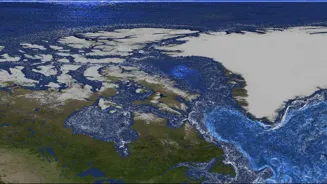New Delhi: The meltwater runoff from Greenland’s ice sheet is churning material at ocean floor, kicking up nutrients that fuel the growth of microscopic
drifting plants called phytoplankton. The grinding ice sheet melts the water beneath it, shedding about 266 billion metric tons of ice each year. The fresh meltwater plume rises through the salty sea water, carrying nutrients such as iron and nitrate closer to the surface, where the phytoplankton float. These tiny organisms are the grass of the sea, occupying the bottom of the entire marine food web. Between 1998 and 2018, phytoplankton growth in the Arctic waters surged by 57 per cent.
The researchers relied on supercomputer simulations to better understand what was happening in the waters under the most active Greenland glacier, the Jakobshavn Glacier, using data from oceanic and orbital instruments collected over three decades. There were billions of data points, including water temperature, salinity and pressure at the seafloor. Beneath this remote glacier, about 1,200 cubic meters of fresh water is injected into the sea every second, during the summers. The researchers intend to extend the simulation to the entire Greenland coast, which has over 250 glaciers. More time is necessary to better understand the impact on the ecosystem.
Impact on the ecosystem
The injection of water by the glaciers into the sea is expected to accelerate over the next few decades. The impact varies widely from the saltiness of coastal waters, to land vegetation to sea level rise. The runoff alters the chemistry and temperature of seawater, making it less likely to dissolve carbon dioxide, which is offset by the phytoplankton blooms taking up more carbon dioxide for photosynthesis from the air. The researchers simulated biology, chemistry and physics at once, with the underlying tools having wide-spread applications that can be used to probe different scenarios around the world. A paper describing the research has been published in Nature Communications.













